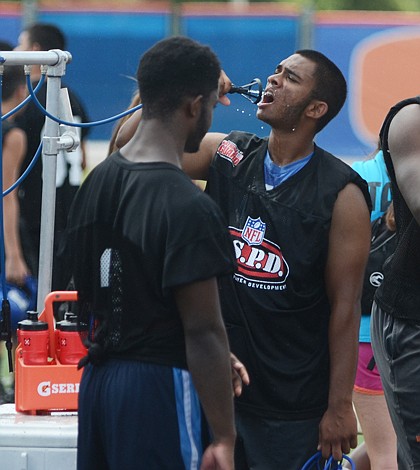- January 16, 2025
-
-
Loading

Loading


There’s a duality of sorts at play at each and every fall camp in the area — from high school to youth football programs.
As the beginning of the season draws nearer for each respective team, coaches find themselves trying to manage the duality of getting their players in game-shape and pushing their athletes outside of their comfort zones, while also doing what they have to in order to ensure their players’ safety and well-being.
For programs with championship aspirations, it can be a tough balance to strike — but Dr. Phillips head coach Rodney Wells says it is certainly doable.
“That’s always a thin line — you’ve got to be physical in practice … and do things as close to live-action as you can,” Wells said after the Panthers’ concluded their first week of fall camp this past Friday. “At the same time, you’ve got to make sure you don’t bang your guys up.”
In recent years, player safety has become more of a central priority to football programs than ever before. “Old school” approaches have been replaced by a greater awareness of keeping players hydrated, teaching players to tackle correctly and limiting the amount of hitting in practice.
Water breaks are frequent for local high school programs, some of which practiced during the first week of fall camp in the morning and afternoon hours, when the Florida sun can be brutal.
The FHSAA even approved a heat acclimatization policy in 2013 that all programs must follow. The policy included time limits on practices during the first two weeks and guidelines on when players can begin contact drills.
Conditioning is a big part of the beginning of practice for any program. And Windermere Prep head coach Jacob Doss said he and his staff make an extra effort to keep an eye on those athletes who might not have attended summer workouts and 7-on-7 passing leagues to ensure they don’t push themselves too hard in the first few days to keep up with the kids who hadn’t missed a beat.
“Those are the kids we really need to monitor,” Doss said. “Obviously, for a football coach, safety is our No. 1 concern.”
Across the board, area coaches said significant portions of practice time have been dedicated to reinforcing correct tackling form to limit the risk of head injuries and concussions.

Central Florida Christian Academy head coach Michael Bonneville said his program utilized a video series on the matter put together by Seattle Seahawks head coach Pete Carroll and that they spent time during non-contact portions going over the information so that good form will be instinctive in game situations.
At the youth level, Pop Warner Football, the Central Florida Youth Football League and the Florida Youth Football and Cheer League follow guidelines and certification of USA Football’s “Heads Up Tackling” program.
Pop Warner also instituted rule changes in 2012 to curb the amount of contact in practice sessions.
Sarah Boudreaux, treasurer and registrar for the West Orange Bobcats — which has teams that compete in the FYFCL — says the increase in awareness over her time with the program, dating back to 2007, has been substantial.
“Everyone’s more aware of concussions and the heat (dangers) and we all (coaches and volunteers) have to take these courses and be up to date,” Boudreaux said. “I think they (parents) should feel more comfortable with (letting their sons play).”
In all, many programs see the safety measures as a win-win, as they keep athletes safe — and healthy for game day, too.
“That’s what we’re trying to emphasize,” Bonneville said. “We don’t want to beat each other up at practice.”